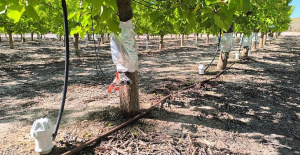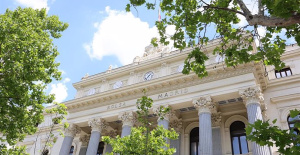Request details of who the gang leaders were at the time of the attack and what their roles were
MADRID, 26 Oct. (EUROPA PRESS) -
The judge of the National High Court, Alejandro Abascal, has promoted the investigation into the attack perpetrated by ETA against the Ertzaintza police station in Ondarroa (Vizcaya), requesting the Basque regional police to prepare a report detailing the functions of the former heads of the gang whom he investigates as alleged 'masterminds' of the attack.
In an order this Monday, to which Europa Press has had access, the person in charge of the Central Court of Instruction Number 1 urges the agents to report on the "name-to-name composition of the entire command structure of ETA, intermediate and superior of the ZUBA or Executive Committee at the time" of the attack that took place on September 21, 2008 and which resulted in 18 injuries and considerable material damage.
Specifically, the instructor orders the investigators to specify "the different devices in which each of the defendants was integrated at the time of the events, also specifying the different sub-devices into which they were divided, and identifying their members and their operation. at the time of the events".
This diligence comes after Abascal admitted on July 10 to processing the complaint filed by the Dignity and Justice Association (DyJ), accusing Aitzol Iriondo, 'Gurbitz' or 'Barbas'; Mikel Carrera, 'Ata'; Ainhoa Ozaeta, 'Kuraia' and Garikoitz Aspiazu Rubina, alias 'Txeroki' for their "alleged responsibility as members of the Executive Committee" of the band.
The magistrate made the decision to investigate 'Txeroki' himself despite the fact that the Criminal Chamber of the National High Court agreed that same month to provisionally file the case that was open against him when considering, in accordance with the Prosecutor's Office and the defense, that there was not enough evidence that he gave the order to attack the police station.
However, the instructor justified "the reopening of the process" by stating "new data acquired later". Abascal then recalled that the data provided by DyJ allowed him "to make a provisional assessment to reopen the case against Aspiazu Rubina."
It dealt, specifically, with information "that was unknown at the time the exculpatory resolution was issued" and that, in the opinion of the instructor, "makes his participation and responsibility plausible" in the Ondarroa attack.
DyJ sent the judge a letter last June in which he pointed out that "the loaf of bread on the dashboard" was the very unique 'modus operandi' and 'criminal brand' of the defendant Txeroki and his ZUBA", the executive body of ETA The association explained that this signature had been used in the Ondarroa attack.
Thus, the judge asks the Basque police to put "special interest" in the military, political and logistical apparatus and all the members that made them up, and who would allegedly be the other four former leaders of the gang. The magistrate requests that "special" attention be paid to the logistics apparatus "given the very unique means of commissioning (explosives)" used.
The judge also asks that he detail the 'modus operandi' of ETA's "internal management mechanisms and decision-making in its Executive Committee" and that he "provide a copy of the ETA statement" or the "claim for the Ondarroa attack and all the bomb attacks in the second half of 2008".
Additionally, the magistrate requests that "all documentation and evidence that could have emerged from any other arrest or police action, in relation to the facts that are the subject" of the complaint filed by the association, be provided.
In addition, the investigator urges the agents to send him "information or evidence that could have been seized in relation to the internal communication" as well as "evidence in relation to the 'fungible' or interchangeable nature of the members of ETA within the organization."
Finally, Judge Abascal asks for a "detailed study and comparison of the remains of the device and explosives, and in general of any indication (fingerprinting or of any other type), of the Ondarroa attack."

 Exploring Cardano: Inner Workings and Advantages of this Cryptocurrency
Exploring Cardano: Inner Workings and Advantages of this Cryptocurrency Seville.- Economy.- Innova.- STSA inaugurates its new painting and sealing hangar in San Pablo, for 18 million
Seville.- Economy.- Innova.- STSA inaugurates its new painting and sealing hangar in San Pablo, for 18 million Innova.- More than 300 volunteers join the Andalucía Compromiso Digital network in one month to facilitate access to ICT
Innova.- More than 300 volunteers join the Andalucía Compromiso Digital network in one month to facilitate access to ICT Innova.-AMP.- Ayesa acquires 51% of Sadiel, which will create new technological engineering products and expand markets
Innova.-AMP.- Ayesa acquires 51% of Sadiel, which will create new technological engineering products and expand markets Eurovision disqualifies the Netherlands for "inappropriate behavior" following an "incident" after the semi-final
Eurovision disqualifies the Netherlands for "inappropriate behavior" following an "incident" after the semi-final Jorge Martín signs a record pole in Le Mans against Bagnaia
Jorge Martín signs a record pole in Le Mans against Bagnaia Russia redoubles its attacks on Kharkiv during the last hours and launches more than 120 bombings on the front
Russia redoubles its attacks on Kharkiv during the last hours and launches more than 120 bombings on the front Israel urges residents of ten other areas of Rafah to leave the area immediately
Israel urges residents of ten other areas of Rafah to leave the area immediately How Blockchain in being used to shape the future
How Blockchain in being used to shape the future Not just BTC and ETH: Here Are Some More Interesting Coins Worth Focusing on
Not just BTC and ETH: Here Are Some More Interesting Coins Worth Focusing on The CSN finances an IFIC project to evaluate a technology that improves nuclear waste management
The CSN finances an IFIC project to evaluate a technology that improves nuclear waste management Expociència expects to receive more than 4,000 visitors in the Science Park of the University of Valencia
Expociència expects to receive more than 4,000 visitors in the Science Park of the University of Valencia They develop devices for the precise diagnosis of cancer patients
They develop devices for the precise diagnosis of cancer patients UMH researchers are working on a high-quality apricot crop that requires less irrigation water
UMH researchers are working on a high-quality apricot crop that requires less irrigation water A million people demonstrate in France against Macron's pension reform
A million people demonstrate in France against Macron's pension reform Russia launches several missiles against "critical infrastructure" in the city of Zaporizhia
Russia launches several missiles against "critical infrastructure" in the city of Zaporizhia A "procession" remembers the dead of the Calabria shipwreck as bodies continue to wash up on the shore
A "procession" remembers the dead of the Calabria shipwreck as bodies continue to wash up on the shore Prison sentences handed down for three prominent Hong Kong pro-democracy activists
Prison sentences handed down for three prominent Hong Kong pro-democracy activists ETH continues to leave trading platforms, Ethereum balance on exchanges lowest in 3 years
ETH continues to leave trading platforms, Ethereum balance on exchanges lowest in 3 years Investors invest $450 million in Consensys, Ethereum incubator now valued at $7 billion
Investors invest $450 million in Consensys, Ethereum incubator now valued at $7 billion Alchemy Integrates Ethereum L2 Product Starknet to Enhance Web3 Scalability at a Price 100x Lower Than L1 Fees
Alchemy Integrates Ethereum L2 Product Starknet to Enhance Web3 Scalability at a Price 100x Lower Than L1 Fees Mining Report: Bitcoin's Electricity Consumption Declines by 25% in Q1 2022
Mining Report: Bitcoin's Electricity Consumption Declines by 25% in Q1 2022 Oil-to-Bitcoin Mining Firm Crusoe Energy Systems Raised $505 Million
Oil-to-Bitcoin Mining Firm Crusoe Energy Systems Raised $505 Million Microbt reveals the latest Bitcoin mining rigs -- Machines produce up to 126 TH/s with custom 5nm chip design
Microbt reveals the latest Bitcoin mining rigs -- Machines produce up to 126 TH/s with custom 5nm chip design Bitcoin's Mining Difficulty Hits a Lifetime High, With More Than 90% of BTC Supply Issued
Bitcoin's Mining Difficulty Hits a Lifetime High, With More Than 90% of BTC Supply Issued The Biggest Movers are Near, EOS, and RUNE during Friday's Selloff
The Biggest Movers are Near, EOS, and RUNE during Friday's Selloff Global Markets Spooked by a Hawkish Fed and Covid, Stocks and Crypto Gain After Musk Buys Twitter
Global Markets Spooked by a Hawkish Fed and Covid, Stocks and Crypto Gain After Musk Buys Twitter Bitso to offset carbon emissions from the Trading Platform's ERC20, ETH, and BTC Transactions
Bitso to offset carbon emissions from the Trading Platform's ERC20, ETH, and BTC Transactions Draftkings Announces 2022 College Hoops NFT Selection for March Madness
Draftkings Announces 2022 College Hoops NFT Selection for March Madness
























